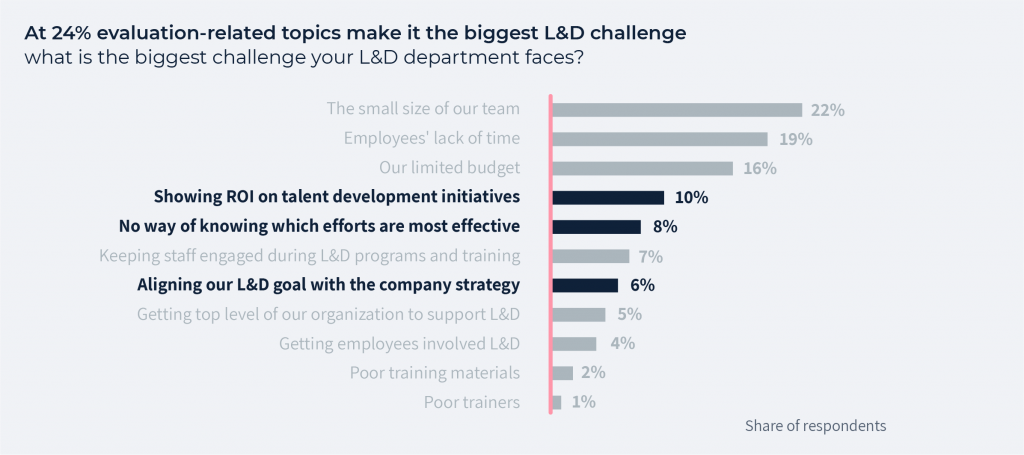It’s time we had a talk about how we look at learning and development (L&D) programs. Technology is upending the way we measure the success of each department in the organization. Finite-level data measurement at every customer touchpoint has become the norm. The impact on KPIs and other success metrics across the organization — from marketing and R&D to product, customer support and sales — is spurring new levels of efficiency and productivity.
Surprisingly, when it comes to measuring the success of organizational L&D programs, things haven’t changed much. The internet, and the digital transformation that has come in its wake, have left the way we measure employee development programs almost completely untouched. But luckily for us, all that’s about to change.
Presenting: L&D 2.0
The world of L&D is in the midst of a huge evolutionary shift. The onset of recent trends such as digital transformation and automation in the workplace, coupled with the financial impact of Covid-19, are forcing us to reshuffle the cards on the way we perceive, measure and utilize L&D programs.
According to research from Statistica, nearly 25% of L&D departments report that showing ROI on initiatives is the biggest challenge they face.

The good news is that after trying Elevation’s products, L&D executives reported that they expected that Elevation’s products and services can help to realign L&D success metrics towards ROI measurements. Elevation’s unique methodology of assessment, training and improvement is especially suited to quantifiable measurement and can be easily configured towards ROI metrics. In addition, they reported that they expected that the realignment enabled by Elevation has the potential to solve many of the other common L&D challenges:
Limited budgets
- No way of knowing which efforts are most effective
- Keeping staff engaged during L&D training
- Aligning L&D goals with company strategy
- Getting executive to support L&D
- Getting employees involved in L&D
Just as ROI was introduced as a quantitative measurement of marketing success with the pivot to online marketing, forward-thinking companies are beginning to align the metrics of their L&D programs with the relative effect of their outcome on the bottom line. Quantifiable metrics representing hiring and staffing savings achieved through reskilling should be attached to each and every L&D graduate.
The attitude towards L&D is shifting from being just an employee benefit aimed at improving motivation, to a strategic organizational asset that can also secure a competitive edge well into the future. This seismic shift means that similar to other strategic activities across the enterprise, L&D measurement should become data-driven and aligned with business impact metrics. This is the only way to ensure that L&D programs are being run optimally while establishing benchmarks for success to empower ongoing improvement and efficiencies.
Doing More with Less
The impact of Covid-19 means that efficiency and productivity are becoming the only metrics that matter. As budgets shrink and costs are cut, doing more with less has become the official mantra of 2020. Departmental budgets and organizational activities that can’t prove their efficiency will be the first to go.
At the same time, the digital skills gap is only growing. This gap is defined as the difference between the skills employees bring with them to work, and the skills they need to do their job effectively. The proliferation of automation and digital transformation is changing the face of the workforce.
Digital competency and knowledge in software-based worktools have left the realms of ‘nice-to-have’. In the modern workforce they have become mandatory for many jobs. The ability of employees to reskill and upskill is becoming critical to an organization’s success. Organizations’ ability to support on-the-job reskilling through effective L&D programs has become the key to unlocking growth and ensuring competitiveness into the future.

Repositioning L&D
Measuring marginal improvement on the specific skills learned within the context of the L&D programs is the first step in revolutionizing L&D within the organization. The main focus and purpose of these programs is to teach employees relevant, practical skills that will help employers achieve their business goals and reduce turnover. As such, skill improvement is the only true measurement of their effectiveness.
- Restructuring L&D’s place within the organization To achieve this, organizations will need to begin implementing ongoing skill assessment, training and measurement as central tenets of their operations and culture.
- Aligning L&D metrics to business impact The best way to ensure that L&D remains relevant and effective in these uncertain times, and into the future, is by aligning their impact with the business metrics that matter to organizational decision-makers.
- Connecting output to success It is only after a clear line can be drawn between the output of L&D programs — skill learning, management and improvement — and the way they are measured, can L&D take its rightful place as a key driver of employee development and business value.
Parting Words & Key Takeaways
Measuring the effectiveness of L&D programs by completion rates is like measuring your product by the number of signups. It only offers a partial picture. As budgets tighten and the need to reskill and upskill employees becomes acute, the need for effective L&D programs is becoming more and more salient. To adjust to this reality, measurement of L&D effectiveness must be aligned with ROI to remain relevant.







